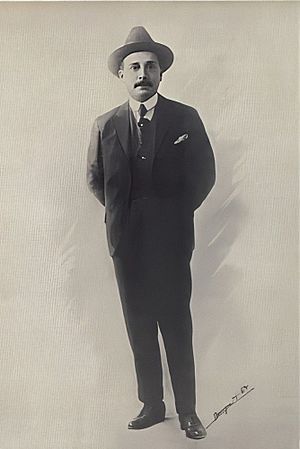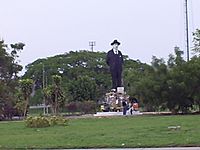José Gregorio Hernández facts for kids
Quick facts for kids BlessedJosé Gregorio Hernández Cisneros O.F.S. |
|
|---|---|
 |
|
| Layman | |
| Born | 26 October 1864 Isnotú, Trujillo, Venezuela |
| Died | 29 June 1919 (aged 54) Caracas, Venezuela |
| Venerated in | Roman Catholic Church |
| Beatified | 30 April 2021, Colegio La Salle La Colina, Caracas, Venezuela by Archbishop Aldo Giordano |
| Feast | 26 October |
| Attributes | Doctor's coat |
| Patronage | Medical students Diagnosticians Doctors Medical patients |
José Gregorio Hernández Cisneros was a famous Venezuelan doctor. He was born in Isnotú, a small village in Trujillo State, on October 26, 1864. He became very well-known, especially after he died. The Catholic Church recognized him as a saintly person in 2021. This process is called beatification.
Contents
Early Life and Education
José Gregorio Hernández Cisneros spent his childhood in Isnotú. His mother was a housekeeper. His father sold medicines and animals. José was baptized on January 30, 1865. He received another important church sacrament, Confirmation, in 1867.
When he was thirteen, José wanted to become a lawyer. But his mother convinced him to study medicine instead. In 1878, he traveled from his home in the Andes Mountains to Caracas. He enrolled in Colegio Villegas, a top school. He graduated from there in 1882.
After high school, Hernández went to Universidad Central de Venezuela (UCV). He studied medicine there for six years. His teachers said he was an excellent student. He always had great grades and behaved very well.
His Career as a Doctor
In 1888, Hernández became a medical doctor. He graduated from Universidad Central de Venezuela in Caracas. The Venezuelan government gave him a special grant. This allowed him to study more in Europe.
Hernández traveled to Paris, France. There, he learned about many new medical fields. These included bacteriology (the study of germs) and pathology (the study of diseases). He also studied microbiology, histology, and physiology. When he returned to Venezuela, he became a leading doctor. He worked at the Hospital José María Vargas.
Between 1891 and 1916, Hernández taught medicine. He also practiced as a doctor and was very religious. He tried twice to become a priest. However, his health was too fragile. He studied in a monastery in Italy for ten months in 1908. In 1913, he tried again in Rome. But he had to return to Venezuela because he was not well.
Hernández wrote several scientific books. These included The Elements of Bacteriology (1906). He also wrote About the Angina Pectoris of Malaric Origin (1909). His book The Elements of Philosophy came out in 1912.
He was known for helping poor people. He treated them for free. He even bought medicines for them with his own money.
When the 1918 Spanish flu arrived in Venezuela, Hernández helped many sick people. He cared for those who were contagious in Caracas. Sadly, Hernández died in 1919. He was hit by a car. His body is now in La Candelaria Catholic Church in Caracas.
Road to Sainthood
After José Gregorio Hernández died, people began to see him as a very special person. Many people across Venezuela said they experienced miracles. They believed these miracles happened after they prayed to God through him. Today, doctors and patients often call on "José Gregorio" for healing. People also ask for his protection when they travel. His name became known throughout Latin America and Spain.
In 1949, Venezuelan Catholic Church officials started a process. They wanted to see if Hernández could become a saint. In 1985, the Vatican gave him the title of Venerable. This means he lived a very holy life.
The next step was beatification. In June 2020, Pope Francis ordered Hernández's beatification. This happened after a girl who was shot in the head recovered. Her recovery was reported as a miracle. It was believed to be a miracle thanks to prayers to Hernández.
His Lasting Legacy

José Gregorio Hernández is also a very important folk figure. He is often shown in naïve art, which is a simple style of art. He is also honored by a Venezuelan religion called the cult of Maria Lionza.
A private university in Maracaibo is named after him. It is called Universidad Dr. José Gregorio Hernández and opened in 2003. In 2008, a special government program was named in his honor. It is called Misión Dr. José Gregorio Hernández. This program helps Venezuelans with disabilities.
On August 26, 2014, the Catholic Bishops Conference of Venezuela asked all Catholics to attend Mass. They wanted people to thank God for Hernández's life. They also hoped for his quick beatification. This was for the 150th anniversary of his birth. His birthday, October 26, is now a "day of national celebration" in Venezuela.
See also
 In Spanish: José Gregorio Hernández para niños
In Spanish: José Gregorio Hernández para niños

